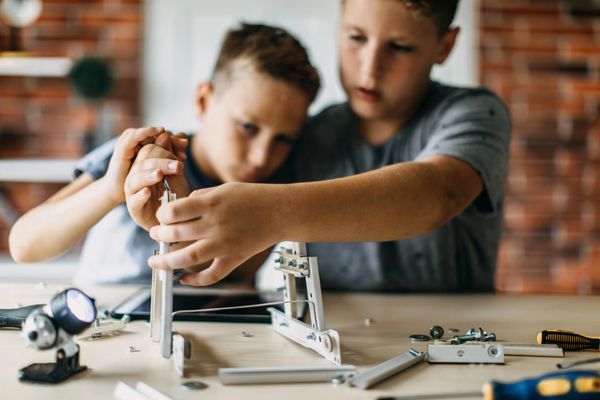Pediatric Occupational Therapy: Where Wonder Leads and Learning Follows
Fine Motor

Fine Motor Development: The Building Blocks of Independence
There's something magical about watching a baby's first purposeful reach for a colorful toy, or seeing a preschooler carefully thread their first bead, or celebrating when a school-age child finally masters tying their shoes. These moments aren't just milestones to check off a list, they're glimpses into the remarkable development happening in your child's hands and brain.
Fine motor skills are the intricate movements of the small muscles in the hands, fingers, and wrists. They're the foundation for so many daily activities we take for granted: holding a spoon, buttoning a shirt, writing a letter, or creating a work of art. But fine motor development is about more than just hand strength. It's deeply connected to cognitive development, problem-solving abilities, and your child's growing sense of independence and confidence.
Understanding fine motor development helps families celebrate the incredible complexity of skills their children are mastering every day. It also helps us recognize when a child might benefit from extra support or different approaches to learning.
These interactive milestone cards are designed to:
- Help you understand the natural progression of fine motor skills from birth through adolescence
- Celebrate your child's unique developmental journey with knowledge and confidence
- Recognize when skills are emerging beautifully and when additional support might be helpful
- Provide realistic expectations for each developmental stag
Remember: Every child's timeline is beautifully unique. These milestones represent what many children explore during these periods, but your child may bloom earlier or later—and both are perfectly wonderful. Development isn't a race; it's a journey of discovery, practice, and growing capability.
The hands are often called "the tools of the brain," and supporting your child's fine motor development is one of the most practical gifts you can give them. These skills will serve them throughout their lives, from the playground to the classroom to their future careers.
Explore each age range below to discover the amazing fine motor journey your child is on.
Fine Motor Developmental Milestones
Fine Motor Development - Research Citations
This research supports the developmental progression and individual variation approach used in the Fine Motor Skills Development flip cards and beyond.
Research That Guides Our Understanding
These fine motor development milestones are grounded in decades of research from developmental pediatrics, occupational therapy, and child development studies. The timeline and expectations presented here reflect current evidence-based practice standards used by pediatric professionals worldwide.
From foundational studies that established our understanding of typical motor development patterns to recent longitudinal research tracking how fine motor skills support academic success, this collection of references represents the scientific foundation behind what we know about children's hand skill development.
Each milestone has been carefully selected to reflect not just what children can do at various ages, but what naturally emerges through typical play, exploration, and daily experiences when children are given appropriate opportunities and support.
Primary Research on Fine Motor Development
WHO Multicentre Growth Reference Study Group. (2006). Assessment of gross motor development in the WHO Multicentre Growth Reference Study. Food and Nutrition Bulletin, 27(4), S104-S119.
- Key Finding: Establishes international reference standards for motor milestone timing across cultures
Johansen, H., et al. (2018). Rapid infant prefrontal cortex development and sensitivity to early environmental experience. PMC, 6157748.
- Key Finding: Critical early brain development impacts fine motor skill acquisition in first year
Choi, B., et al. (2024). Changes in motor competence of 4-8-year-old children: A longitudinal study. Journal of Motor Learning and Development, 12(1), 87-104.
- Key Finding: Motor competence development trajectories and individual variation patterns in school-age children
Meta-analysis of motor milestone associations. (2024). Systematic review of 21,205 individuals showing specific motor delays in neurodevelopmental conditions. PubMed, 39067834.
- Key Finding: Large-scale analysis of fine motor development patterns across diverse populations
Fine Motor Skills and Academic Readiness
Coral Care Developmental Guides. (2023). Developmental milestones for pre-toddlers (12–24 months).
- Key Finding: Systematic documentation of fine motor milestone emergence in second year of life
Yale Medicine. (2023. Understanding fine motor development milestones.
- Key Finding: Current evidence-based fine motor development timelines from infancy through school age
Diamond, A. (2013). Executive functions and fine motor coordination. Annual Review of Psychology, 64, 135-168.
- Key Finding: Connection between fine motor skills and executive function development
Best, J. R., et al. (2011. Fine motor skills and academic achievement. Developmental Psychology, 47(4), 1159-1169.
- Key Finding: Fine motor skills in preschool predict academic success in elementary school
Clinical Applications
Case-Smith, J., & O'Brien, J. (2013). Occupational therapy for children and adolescents. Elsevier Health Sciences.
- Key Finding: Evidence-based fine motor interventions for children with developmental differences
Schneck, C. M., & Henderson, A. (1990). Descriptive analysis of the developmental progression of grip position for pencil and crayon control in nondysfunctional children. American Journal of Occupational Therapy, 44(10), 893-900.
- Key Finding: Normal progression of pencil grip development from toddlerhood through school agehool predict academic success in elementary school
Supporting Research for Specific Age Ranges
Birth-12 Months
- Touwen, B. C. (1976). Neurological development in infancy. Clinics in Developmental Medicine.
- Key Finding: Normal neurological development patterns supporting fine motor emergence
12-24 Months
- Gesell, A., & Amatruda, C. S. (2007). Developmental diagnosis: Normal and abnormal child development. Harper & Row.
- Key Finding: Classic developmental milestone research still relevant for fine motor expectations
2-5 Years
- Marr, D., et al. (2003). Fine motor activities in elementary school: Preliminary findings and provisional implications for children with fine motor problems. American Journal of Occupational Therapy, 57(5), 550-557.
- Key Finding: School-age fine motor demands and intervention implications
School Age and Beyond
- Rosenblum, S., et al. (2006). Handwriting measures as reflectors of executive functions among adults with Developmental Coordination Disorder. Frontiers in Psychology, 7, 436.
- Key Finding: Fine motor skills continue developing through adolescence and support complex tasks